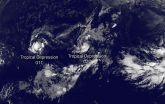(Press-News.org) Five billion years ago, a great disturbance rocked a region near the monster black hole at the center of galaxy 3C 279. On June 14, the pulse of high-energy light produced by this event finally arrived at Earth, setting off detectors aboard NASA's Fermi Gamma-ray Space Telescope and other satellites. Astronomers around the world turned instruments toward the galaxy to observe this brief but record-setting flare in greater detail.
"One day 3C 279 was just one of many active galaxies we see, and the next day it was the brightest thing in the gamma-ray sky," said Sara Cutini, a Fermi Large Area Telescope scientist at the Italian Space Agency's Science Data Center in Rome.
3C 279 is a famous blazar, a galaxy whose high-energy activity is powered by a central supermassive black hole weighing up to a billion times the sun's mass and roughly the size of our planetary system. As matter falls toward the black hole, some particles race away at nearly the speed of light along a pair of jets pointed in opposite directions. What makes a blazar so bright is that one of these particle jets happens to be aimed almost straight at us.
"This flare is the most dynamic outburst Fermi has seen in its seven years of operation, becoming 10 times brighter overnight," said Elizabeth Hays, a Fermi deputy project scientist at NASA's Goddard Space Flight Center in Greenbelt, Maryland. Astronomers think some change within the jet is likely responsible for the flare, but they don't know what it is.
The brightest persistent source in the gamma-ray sky is the Vela pulsar, which is about 1,000 light-years away. 3C 279 is millions of times farther off, but during this flare it became four times brighter than Vela. This corresponds to a tremendous energy release, and one that cannot be sustained for long. The galaxy dimmed to normal gamma-ray levels by June 18.
The rapid fading is why astronomers rush to collect data as soon as they detect a blazar flare. "Our priority is to make observations while the object is still bright," said Masaaki Hayashida, a Fermi team member at the University of Tokyo's Institute for Cosmic Ray Research. "Once it's over, we can start trying to understand the mechanisms powering it."
The Italian Space Agency's AGILE gamma-ray satellite first reported the flare, followed by Fermi. Rapid follow-up observations were made by NASA's Swift satellite and the European Space Agency's INTEGRAL spacecraft, which just happened to be looking in the right direction, along with optical and radio telescopes on the ground.
3C 279 holds a special place in the history of gamma-ray astronomy. During a flare in 1991 detected by the EGRET instrument on NASA's then recently launched Compton Gamma Ray Observatory (CGRO), which operated until 2000, the galaxy set the record for the most distant and luminous gamma-ray source known at the time. "Although we didn't expect to find the galaxy so bright, we soon had a much greater surprise," recalled Robert Hartman, who led the first gamma-ray study of 3C 279 with CGRO and is now a member of the Fermi team at Goddard. "Its brightness varied substantially, becoming four times brighter within 10 days."
The June 14 outburst rapidly brightened in less than a day and peaked on June 16, producing a gamma-ray flare 10 times brighter than the 1991 event. These rapid variations convey information about the size of the emitting region, which cannot be larger than the distance light can travel during the flare.
Mid-June proved to be an intense period for the Fermi team. As the satellite's Large Area Telescope studied 3C 279, its Gamma-ray Burst Monitor became the busiest it has ever been since the start of the mission. The instrument picked up a series of eruptions on the sun, which is unusual in itself, as well as multiple outbursts from V404 Cygni, a binary system containing a black hole that erupts every few decades.
INFORMATION:
NASA's Fermi Gamma-ray Space Telescope is an astrophysics and particle physics partnership mission, developed in collaboration with the U.S. Department of Energy and important contributions from academic institutions and partners in France, Germany, Italy, Japan, Sweden and the United States.
NOAA's GOES-West satellite saw that Hawaii is in the middle of a triangle of tropical cyclones. Tropical Depression 02C formed over 700 hundred miles south-southeast of Hawaii on July 10.
There are three tropical cyclones in the Central Pacific Ocean and Hawaii is in the middle of them. On July 10, newborn Tropical Depression 01C was west of Hawaii, while newborn Tropical Depression 02C was south of the Big Island. Post-Tropical Depression Ela was fizzling northeast of Hawaii.
NOAA's GOES-West satellite provided an infrared image of the newborn depression that showed ...
NOAA's GOES-West satellite saw that Hawaii is in the middle of a triangle of tropical cyclones. Tropical Depression 01C formed hundreds of miles southwest of Hawaii on July 10.
There are three tropical cyclones in the Central Pacific Ocean and Hawaii is in the middle of them. On July 10, newborn Tropical Depression 01C was west of Hawaii, while newborn Tropical Depression 02C was south of the Big Island. Post-Tropical Depression Ela was fizzling northeast of Hawaii.
NOAA's GOES-West satellite provided an infrared image of the newborn depression that showed fragmented ...
An automated thermal detection system that can discern wild elephants from background and other animals in infrared images could save lives in parts of the world where the animals roam free and often enter villages and other human habitation, according to research published in the International Journal of Electronic Security and Digital Forensics.
Siva Mangai and colleagues at Karunya University, in Coimbatore, Tamil Nadu, India, explain how encounters between humans and elephants is a critical safety issue in the Western Ghats region of Tamil Nadu. "The movement of wild ...
NASA's Aqua satellite saw the massive Typhoon Nangka moving out of the Marianas Islands, while NASA's RapidScat instrument pinpointed the location of its strongest winds.
On July 9, the RapidScat instrument that flies aboard the International Space Station, observed Nangka's strongest winds on the western side of the storm, reaching speeds of more than 30 meters per second (108 kph/67 mph). RapidScat scanned the storm's surface winds for about 90 minutes from 1:41 p.m. to 3:14 p.m. EDT.
When Aqua passed over Typhoon Nangka on July 10 at 01:10 UTC (9:10 a.m. EDT ...
NOAA's GOES-West satellite saw that Hawaii is in the middle of a triangle of tropical cyclones. Post-Tropical Depression Ela was located northeast of Hawaii on July 10, and the forecast calls for the storm to move west toward the islands over the weekend of July 11 and 12 and dissipate.
There are three tropical cyclones in the Central Pacific Ocean and Hawaii is in the middle of them. On July 10, newborn Tropical Depression 01C was west of Hawaii, while newborn Tropical Depression 02C was south of the Big Island. Post-Tropical Depression Ela was northeast of the islands ...
RapidScat is an instrument that sits on the International Space Station and reads surface winds over the ocean. It has been invaluable to tropical cyclone forecasters, showing where the strongest winds are located in storms. RapidScat spotted Chan-Hom's strongest winds away from Taiwan as it approached mainland China for landfall.
On July 9, the RapidScat instrument that flies aboard the International Space Station, observed Chan-Hom's strongest winds stretched from the northwestern to southeastern side of the storm, reaching speeds of more than 30 meters per second (108 ...
DETROIT - A Wayne State University School of Medicine professor, in collaboration with researchers at CReAte Fertility Center, University of Toronto, Harvard University and Georgia Reagents University, has developed the first diagnostic test for sperm RNA based on next-generation sequencing. For couples with unexplained infertility, the test may help determine the best infertility treatment for couples having difficulty conceiving.
Published this week in Science Translational Medicine, "Absence of sperm RNA elements correlates with idiopathic male infertility," by the ...
This news release is available in German.
Are wind farms harmful to humans? Some believe so, others refute this; this controversial topic makes emotions run high. To give the debate more objectivity, an international team of experts dealt with the fundamentals of hearing in the lower limit range of the audible frequency range (i.e. infrasound), but also in the upper limit range (i.e. ultrasound). The project, which is part of the European Metrology Research Programme (EMRP), was coordinated by the Physikalisch-Technische Bundesanstalt (PTB). At PTB, not only acoustics ...
July 10, 2015 - For children with cleft lip and palate, the chances of undergoing secondary surgery vary depending on the center where they're treated, reports a study in Plastic and Reconstructive Surgery--Global Open®, the official open-access medical journal of the American Society of Plastic Surgeons (ASPS).
When secondary surgeries are performed, they don't necessarily improve the child's final facial appearance, according to the new research by ASPS Member Surgeon Dr. Thomas J. Sitzman of Cincinnati Children's Hospital Medical Center and colleagues.
Secondary ...
Random-access memory, or RAM, is where computers like to store the data they're working on. A processor can retrieve data from RAM tens of thousands of times more rapidly than it can from the computer's disk drive.
But in the age of big data, data sets are often much too large to fit in a single computer's RAM. The data describing a single human genome would take up the RAM of somewhere between 40 and 100 typical computers.
Flash memory -- the type of memory used by most portable devices -- could provide an alternative to conventional RAM for big-data applications. It's ...





